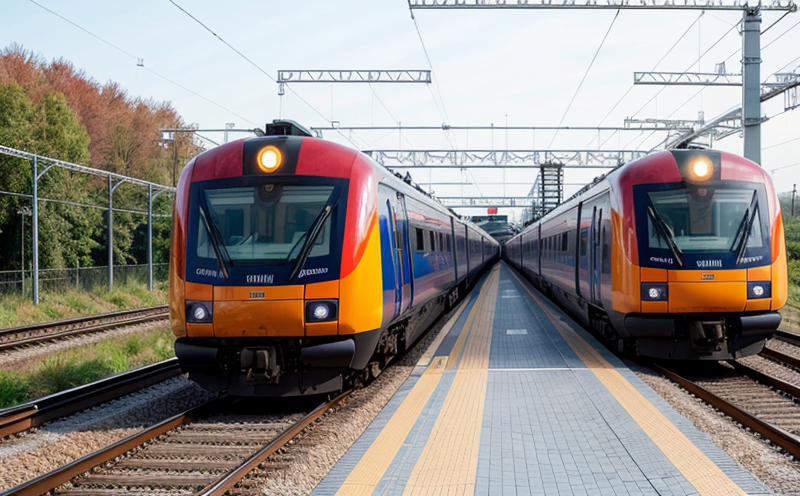EN 50317 Digital Pantograph–Catenary Monitoring Testing
The EN 50317 standard is pivotal for the design, installation, and operation of digital pantograph-catenary monitoring systems. This service is aimed at ensuring that these critical railway components meet stringent performance criteria under real-world conditions. The primary focus is on providing accurate, reliable data to support decision-making in railway infrastructure maintenance and optimization.
The EN 50317 standard specifies the technical requirements for digital devices used to monitor the condition of the pantograph-catenary interface during operation. This monitoring helps identify potential issues that could lead to disruptions or accidents on the railway network. By adhering to this standard, railway operators can enhance safety and efficiency while minimizing downtime.
The testing process involves several key steps. First, the system is calibrated using reference data from known good installations. Then, it undergoes rigorous field trials under various environmental conditions, including temperature extremes, humidity variations, and wind speeds. These tests are designed to simulate real-world operating environments where the pantograph interacts with the catenary.
Data collected during these trials is analyzed against predefined acceptance criteria specified in EN 50317. Acceptance criteria include parameters such as contact pressure, arc duration, and electrical resistance. If any parameter falls outside of acceptable limits, corrective actions must be taken until all measurements conform to the standard.
Once validated, the system is certified as compliant with EN 50317. This certification ensures that the monitoring device meets the necessary technical requirements for safe and efficient railway operation. The testing process also involves validation against international standards like ISO 9001 for quality management systems and IEC 62478 for smart grid applications.
The real-world application of EN 50317 is extensive, covering various aspects of railway infrastructure maintenance. By using this standard, railway operators can achieve several benefits including improved safety through early detection of faults, reduced maintenance costs by prioritizing repairs based on actual data, and enhanced performance leading to increased reliability.
For quality managers, compliance officers, R&D engineers, and procurement personnel involved in the design and deployment of digital pantograph-catenary monitoring systems, this service provides assurance that their equipment meets stringent international standards. This is crucial for ensuring long-term safety and efficiency within railway networks.
Industry Applications
The EN 50317 standard finds application across multiple sectors of the railway industry. It plays a vital role in the development, installation, and maintenance phases of digital pantograph-catenary monitoring systems. These systems are used to monitor critical parameters such as contact pressure, arc duration, and electrical resistance.
- Contact Pressure: Ensures that the pantograph makes consistent and safe contact with the overhead wire, preventing wear and tear on both components.
- Arc Duration: Helps in identifying instances where arcs are formed between the pantograph and the catenary. This can indicate insulation failures or other issues requiring immediate attention.
- Electrical Resistance: Measures the resistance offered by the contact system, helping to detect any degradation that might affect current flow and overall performance.
The data collected from these monitoring systems is crucial for predictive maintenance strategies. By continuously tracking key parameters, railway operators can anticipate when repairs are needed, thus avoiding costly outages. This proactive approach enhances both safety and operational efficiency across the network.
In addition to improving immediate conditions on existing tracks, the application of EN 50317 ensures that new installations meet high standards from the outset. This supports the continuous improvement of railway infrastructure, making it safer and more resilient against future challenges.
Eurolab Advantages
At Eurolab, we pride ourselves on offering comprehensive testing services tailored to your specific needs. Our expertise in EN 50317 compliance ensures that you receive accurate and reliable results every time. Here are some of the advantages our clients enjoy:
- Comprehensive Testing Services: We offer a full range of tests designed to meet all aspects of the EN 50317 standard.
- State-of-the-Art Facilities: Our laboratories are equipped with advanced instrumentation and software capable of capturing precise measurements across various environmental conditions.
- Experienced Professionals: Our team comprises highly skilled engineers and technicians who have extensive experience in railway infrastructure testing.
- Comprehensive Reporting: We provide detailed reports that not only meet regulatory requirements but also offer actionable insights for ongoing improvements.
By partnering with Eurolab, you gain access to cutting-edge technology and a wealth of expertise dedicated to ensuring compliance with international standards. Our commitment to quality is reflected in every aspect of our service, from initial consultation through final certification.
Quality and Reliability Assurance
The process of EN 50317 digital pantograph-catenary monitoring testing involves several stages aimed at ensuring high levels of accuracy and reliability. Here’s an overview of the key steps:
- Calibration: Before any field trials, the system is calibrated using reference data from known good installations.
- Field Trials: The system undergoes rigorous testing under various environmental conditions to simulate real-world operations.
- Data Analysis: Collected data is analyzed against predefined acceptance criteria specified in EN 50317.
- Certification: If all measurements conform to the standard, the system is certified as compliant with EN 50317.
The calibration process ensures that all instruments are operating within acceptable tolerances. This step is crucial for obtaining accurate results during field trials. During these trials, multiple parameters such as contact pressure, arc duration, and electrical resistance are measured under different environmental conditions to ensure consistent performance across all scenarios.
Data analysis involves comparing the collected data against predefined acceptance criteria specified in EN 50317. This ensures that the system meets the necessary technical requirements for safe and efficient railway operation. If any parameter falls outside of acceptable limits, corrective actions must be taken until all measurements conform to the standard.





